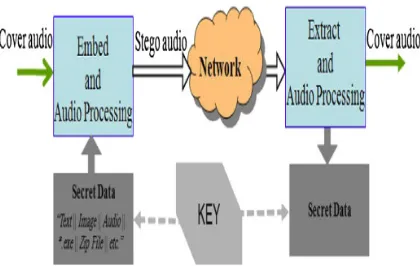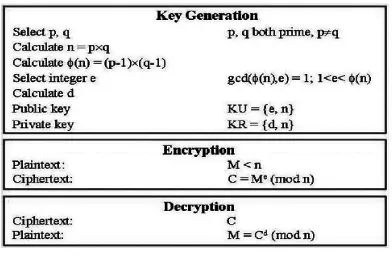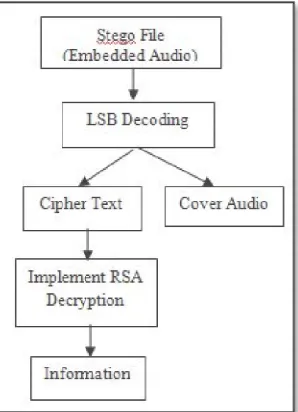IJSRR, 8(1) Jan. –March, 2019 Page 71
Research article Available online www.ijsrr.org
ISSN: 2279–0543
International Journal of Scientific Research and Reviews
Securing Text Message Using Audio Steganography and Cryptography
Rasmi M
Dept. of Computer Science and Applications, St. Mary’s College, Thrissur-680020 Kerala, India Email: m.rasmi.m@gmail.com
ABSTRACT
Today’s large demand of internet applications requires data to be transmitted in a secure manner.
Data transmission in public communication system is not secure because of interception and
improper manipulation by eavesdropper. So the attractive solution for this problem is Steganography
and Cryptography. Steganography hides secret information into a cover medium and Cryptography
convert data into an unrecognizable form. The proposed algorithm is an amalgamation of text
encryption, audio steganography and audio encryption. The original text message is encrypted using
RSA algorithm. This cipher text gets embedded into the cover audio using LSB encoding. This
scrambled audio is transmitted to the receiver which carries the encrypted secret data. Audio
steganography is scheme of hiding the existence of secret information by concealing it into another
medium such as audio file. It will give more protection to the data.
*Corresponding author
Rasmi M
Assistant Professor,
Dept. of Computer Science and Applications,
St. Mary’s College, Thrissur-20
IJSRR, 8(1) Jan. –March, 2019 Page 72
INTRODUCTION
The network security is becoming more important as the volume of data being exchanged
over the internet increases day by day1. Two important techniques for providing security are:
STEGANOGRAPHY
As the need of security increases only encryption is not enough. So stegnograpghy is the
supplementary to encryption. It is not the replacement of encryption. But Steganography along with
encryption gives more security to data. The word steganography is of Greek origin and means
"concealed writing" from the Greek words stegnos meaning "covered or protected", and graphei
meaning "writing". Steganography is the technique to hide the information in some media so that
third party can’t recognize that information is hidden into the cover media. That media may be text,
image, audio or video. The information that to be hidden is called stego and the media in which the
information is hidden is called host. The stego object can be text, image, audio or video. When the
information is hidden into the audio then it is called Audio steganography2.
Fig 1: Steganography
USES OF STEGANOGRAPHY
1. Steganography can be a solution which makes it possible to send news and information
without being censored and without the fear of the messages being intercepted and traced
back to us.
2. It is also possible to simply use steganography to store information on a location. For
example, several information sources like our private banking information, some military
secrets, can be stored in a cover source. When we are required to unhide the secret
information in our cover source, we can easily reveal our banking data and it will be
impossible to prove the existence of the military secrets inside3.
3. The transportation of sensitive data is another key use of steganography. A potential problem
with cryptography is that eavesdroppers know they have an encrypted message when they see
one. Steganography allows to transport of sensitive data past eavesdroppers without them
Stego Application
Cover file
(image,video or audio)
Data to hide (text, image, etc)
IJSRR, 8(1) Jan. –March, 2019 Page 73
knowing any sensitive data has passed them. The idea of using steganography in data
transportation can be applied to just about any data transportation method, from e-mail to
images on internet websites.
4. E-commerce allows for an interesting use of steganography. Incurrent e-commerce
transactions, most users are protected by a user name and password, with no real method of
verifying that the user is the actual card holder. Biometric finger print scanning, combined
with unique session IDs embedded into the fingerprint images via steganography, allow for a
very secure option to open ecommerce transaction verification4.
Fig 2: Audio Steganography
IMPLEMENTATION
Rsa Algorithm
RSA is an Internet encryption and authentication system that uses an algorithm developed in
1977 by Ron Rivest, Adi Shamir, and Leonard Adleman. The RSA algorithm is the most commonly
used encryption and authentication algorithm and is included as part of the Web browsers from
Microsoft and Netscape. It's also part of Lotus Notes, Intuit's Quicken, and many other products. The
encryption system is owned by RSA security5. The mathematical details of the algorithm used in
obtaining the public and private keys are available at the RSA Website. Briefly, the algorithm
involves multiplying two large prime numbers (a prime number is a number divisible only by that
number and 1) and through additional operations deriving a set of two numbers that constitutes the
IJSRR, 8(1) Jan. –March, 2019 Page 74
Fig 3: RSA Algorithm
LSB CODING
A very popular methodology for audio steganography is the LSB (Least Significant Bit)
algorithm, which replaces the least significant bit in some bytes of the cover file to hide a sequence
of bytes containing the hidden data. That's usually an effective technique in cases where the LSB
substitution doesn't cause significant quality degradation, such as in 24-bit bitmaps6. In computing,
the least significant bit (LSB) is the bit position in a binary integer giving the units value, that is,
determining whether the number is even or odd. The LSB is sometimes referred to as the right-most
bit, due to the convention in positional notation of writing less significant digit further to the right. It
is analogous to the least significant digit of a decimal integer, which is the digit in the ones
(right-most) position7.
PROPOSED SYSTEM
The larger part of today's steganographic frameworks utilizes mixed media items like picture,
sound, feature and so on as spread media in light of the fact that individuals frequently transmit
advanced pictures over email and other internet correspondence. In a machine based sound
steganography framework, mystery messages are installed in advanced sound. The mystery message
is implanted by marginally modifying the twofold grouping of a sound document.
To overcome the drawbacks of existing system, an efficient encryption algorithm should be
used. In proposed technique the algorithm will be implemented for Audio Signal to hide text.
Number, uppercase alphabet or lowercase alphabet, special symbols like !, “ , # , $ , %, & , ( , , ) , *,
+ , ‘, - , . , / is also observed and these special symbols can also be embedded in WAV file. Objective
of the project is to develop a tool that can be used to securely transmit secret messages as well as
data.
RSA is an asymmetric key algorithm, the algorithm that uses different keys for encryption and
decryption purposes. A user can upload the information RSA encoding schemes are used to encrypt
IJSRR, 8(1) Jan. –March, 2019 Page 75 Fig 4: LSB Encoding
As Shown in figure 4, the steps of audio steganography will be as follows;
Upload the information
Implement RSA Algorithm to generate first level encryption
Select the cover audio for embedding.
Embed the cipher text in the selected audio using LSB coding to generate the stego file
Send this stego file to the required destination through the communication channel
And when downloading the audio file, apply LSB decoding algorithm for decoding the data.
Then apply the RSA Decryption algorithm to get the original information. The Block Diagram of
proposed work is shown in following figure:
IJSRR, 8(1) Jan. –March, 2019 Page 76
As Shown in figure 5, the steps of decryption will be as follows:
Take the stego file (embedded audio)
Apply LSB decoding algorithm to extract text and cover audio
Use RSA decryption algorithm on the extracted text to generate Plain Text.
Plain Text will be displayed to the User.
Proposed Audio Steganography framework is a strategy for information stowing away is the
methodology of concealing data behind the wave record that is transporter document. The message is
initially scrambled and after that installed in the transporter. It can also be used in forensic
application to conceal data as well as in the music industry to monitor data sharing. For Protection of
copyrighted digital media and government information system security and covert communications,
data can hide in audio and video files8.
ADVANTAGES:
1. Audio based Steganography has the potential to conceal more information:
Audio files are generally larger than images
Our hearing can be easily fooled
Slight changes in amplitude can store vast amounts of information
2. The flexibility of audio Steganography is makes it very potentially powerful :
3. Another aspect of audio Steganography that makes it so attractive is its ability to combine with
existing cryptographic technologies.
4. Greater amounts of information can be embedded without audible degradation
5. Security :
Many attacks that are malicious against image Steganography algorithms cannot be
implemented against audio Steganography schemes. Consequently, embedding information
into audio seems more secure due to less steganalysis techniques for attacking to audio.
As emphasis placed on the areas of copyright protection, privacy protection, and surveillance
increases, Steganography will continue to grow in importance as a protection mechanism.
CONCLUSION
The steganography is one of the safest forms of data transmissions in this digital world. In
our proposed method, audio steganography is enhanced more by means of cryptographic key
algorithms. The message signal is transmitted with utmost security and can be retrieved without any
loss in transmission in this method. Apart from lossless transmission this method easily blinds the
IJSRR, 8(1) Jan. –March, 2019 Page 77
and serves better in both aspects. The output waveforms show that the recovered message resembles
exactly as that of the transmitted message. Similarly, the carrier and transmitted signal resembles the
same
.
These results shows that this method is lesser prone to error while transmission. Hence, thismethod is well suited for digital data transmission through internet and other communication
systems.
REFERENCES
1. Nishith Sinha, Anirban Bhowmick, B. Kishore, “Encrypted Information Hiding using Audio
Steganography and Audio Cryptography”, International Journal of Computer Applications, ,
February 2015; 112 – No. 5
2. K.P. Adhiya Swati A. Patil CSE Dept. SSBT’s COET Bambhori, Jalgaon, Bambhori, India,
“Hiding Text in Audio Using LSB Based Steganography”, Information and Knowledge
Management 2012; 2(3).
3. A.P. Petitcolas, R.J. Anderson, M.G. Kuhn,” Information Hiding- A Survey”, Process of
IEEE, July 1999; 87(7): 1062-1078,
4. Arvind Kumar, Km. Pooja, “Steganography- A Data Hiding Technique”, International
Journal of Computer Applications November 2010; 9– No.7,
5. Gurpreet Singh, Supriya, “A Study of Encryption Algorithms (RSA, DES, 3DES and AES)
for Information Security”, International Journal of Computer Applications (0975 – 8887),
April 2013;67– No.19,
6. Nedeljko Cvejic, Tapio Seppben, “Increasing the capacity of LSB-based audio
steganography”, FIN90014 University of Oulu, Finland ,2002.
7. Mohammad Pooyan, Ahmad Delforouzi, “LSB based Audio Steganography Method Based
on Lifting Wavelet Transform”, IEEE International Symposium on Signal Processing and
Information Technology, 2007.
8. Gunjan Nehru, Puja Dhar, “A Detailed look of Audio Steganography Techniques using LSB
and Genetic Algorithm Approach”, IJCSI International Journal of Computer Science, Issues,


